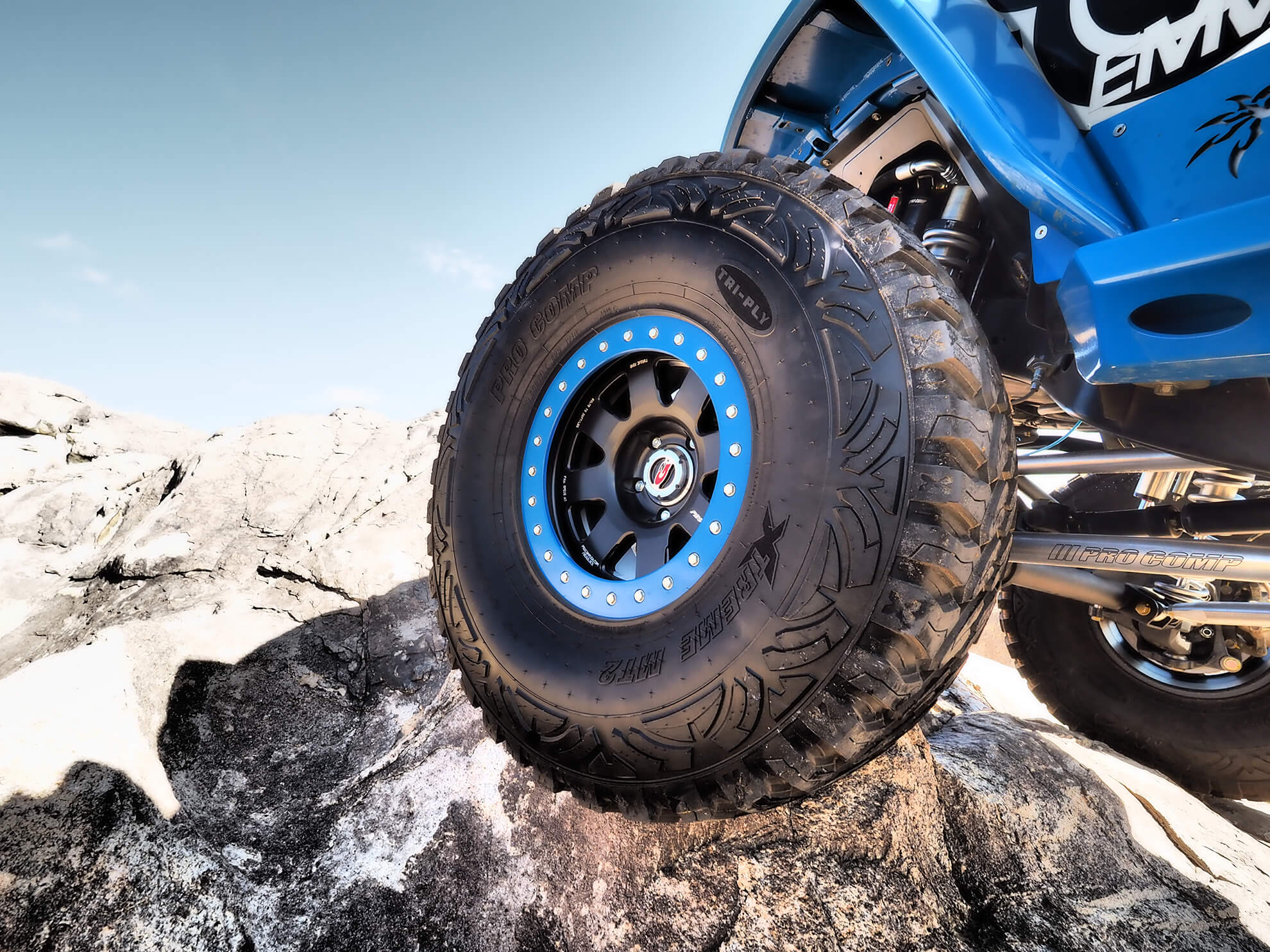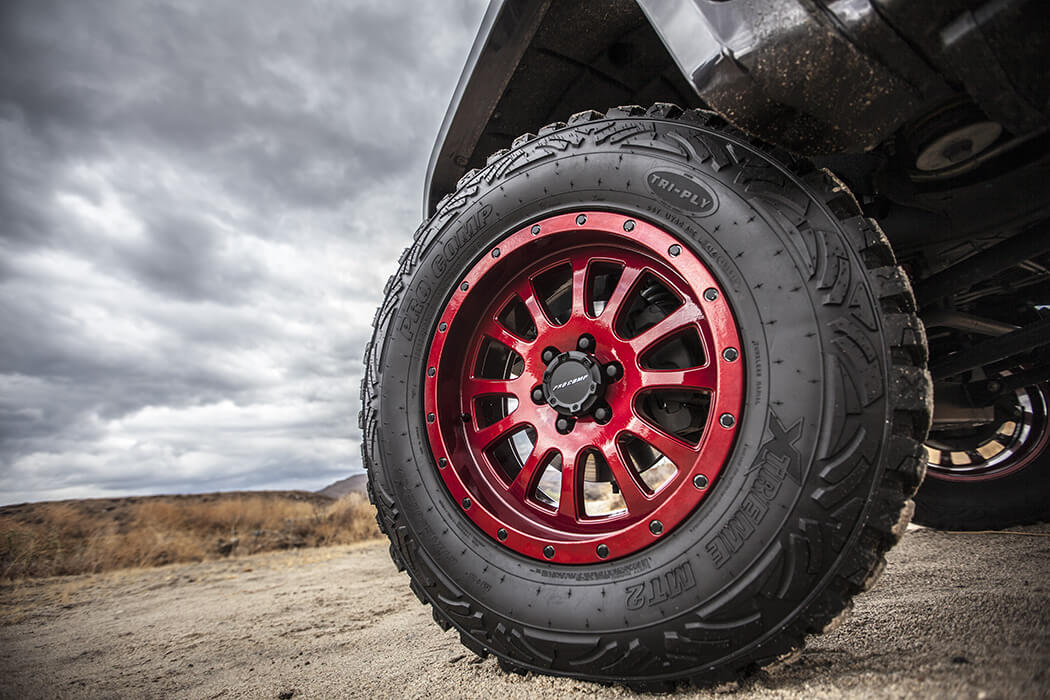
One of the most popular modifications for any SUV, truck, or Jeep is a new set of tires and wheels. Even if the rest of the vehicle remains bone stock, the vast majority of us put on some new tires wrapped around swanky new wheels. Better tires provide more traction and puncture resistance, while almost any aftermarket wheel looks better than plain Jane stockers.
Most of us select wheels on looks alone. Looks are important. Put the right set on and your rig will look awesome. Pick the wrong ones and it can appear downright funky, regardless of what the rest of your 4×4 looks like. Wheels can definitely make or break a vehicle.
Even if you’re satisfied with the current shoes for your ride, there are always new styles coming out. Wheel designers must be pretty busy people. They are constantly coming out with new wheels, and they always seem to look better than the ones we have on our rig. We’re always looking for an excuse to get rid of our current wheels and somehow score some new ones.
Just like the tires that go around them, when it comes to wheels there is more to consider than looks alone. Sure, looks are definitely a consideration, but factors like materials, diameter, fitment, and finish make a difference. Fall in love with a wheel just for its looks and you could wind up regretting it in the long run. Let’s take a look at what you should consider before buying your next set of wheels.
Materials
What your wheels are made of matters. In the past, the vast majority of wheels were built out of steel. Cheap and easy to manufacture, steel made sense for a basic set of wheels. Some OEM wheels on lower trim level vehicles are still made out of steel simply because they’re cheap to produce.
For someone looking for a basic set of wheels, steel still makes sense. Some of the pros of steel wheels are that they are much cheaper than their aluminum counterparts, typically costing at least 50% less. They’re also fairly strong and can be beat back into shape should they get bent. The cons are that steel wheels tend to weigh more and can be limited in styles.
Most modern wheels are made of aluminum. Many people consider aluminum wheels to be stronger than steel wheels, but that’s not the case. Steel is actually stronger, and an aluminum wheel will deform and crack easier. So why run aluminum wheels? The main benefit is that aluminum weighs significantly less than steel. And, with the right type of aluminum and construction techniques, they are still plenty strong. Another reason aluminum is favored over steel it is much more malleable. This allows it to be shaped into a much wider variety of styles than steel wheels. With manufacturing techniques always evolving, the styles available seem to be endless.

Construction
There are two common construction techniques when it comes to making aluminum wheels: casting and forging. Casting is the more common of the two and takes molten aluminum and pours it into a mold to create the shape of a wheel. Forging takes a semi-molten ingot of aluminum and squeezes it into a shape.
It might seem like a subtle difference, but forging produces a stronger wheel. The compression that takes place in the forging process eliminates air bubbles that can weaken a wheel. It creates a finer grain structure in the metal, which adds strength as well. While all that is good, the drawback is that the forging process is more complicated and therefore more expensive.
So is the extra expense of a forged wheel worth it? It depends. If you constantly blow apart cast wheels because you think your vehicle is an Ultra4 or a Trophy Truck, then yes, probably. If you need the higher load ratings that the strength of forged wheels offer because you are hauling lots of weight, then they are definitely worth consideration. Otherwise a cast wheel should be just fine.
Offset And Backspacing
Offset and backspacing are two different ways of essentially measuring the same thing: the amount the wheel sticks out from its mounting location. Backspacing is the more commonly used term and is the measurement from the inside edge (when mounted) of the wheel to the mounting face. The less backspacing, the further the wheel sticks out, and vice versa.
Offset is the distance from the exact center of the wheel to its mounting face. A lower offset wheel will move the wheel outward from the vehicle’s hub. The opposite is true for a higher offset wheel.
While it might seem like a trivial measurement, it is important. Many suspension companies recommend a specific backspacing that works with their lift kits. Not following that advice can lead to tires that heavily rub in certain situations, and a reduced turning radius.

Diameter
For whatever reason, huge diameter wheels are all the rage now. Before you donk out your ride, there are a few things to consider about big wheels. First, as wheels get bigger, the sidewall of the tire decreases. This is important because there is less sidewall to absorb impacts both on- and off-road, leading to a rough ride. You can’t air down as much because of the shorter sidewall, either. It is also easier to blow a bead if you do air down. And, as wheels get larger they also weigh more. If you like the looks of bigger diameter wheels and don’t plan to go in the dirt, then none of this matters. However, if you still want to hit the trail, plan to stick with a smaller diameter wheel, like a 17-inch one.
Load Ratings
Like tires, wheels have a load rating. The rating is often stamped on the inside of the wheel and can be found on most manufacturers’ websites. If you are driving a Jeep, ½-ton pickup, or other light-duty vehicle, you will probably be well within the weight rating of most wheels. If you haul lots of weight with a heavier 1-ton truck, you will definitely want to pay attention to the weight rating of the wheels you plan to buy.

Weight
Sport car owners are fanatical about the weight of wheels and will spend significant amounts of money for slightly lighter ones. They know how extra pounds of unsprung weight can significantly affect handling, braking, and acceleration. This doesn’t just apply to sports cars. It’s true whether you are in a Jaguar or a Jeep. An excessively heavy wheel and tire combo can lead to more broken drivetrain parts, as well.
Someone bolting tons of armor and heavy axles onto a Jeep is usually less concerned about weight, so the weight of off-road wheels can be hard to find on a manufacturer’s website. Most don’t list weights for their wheels at all, but you can somewhat “visualize” the weight of a wheel. Bigger wheels and wheels with more material are going to weigh more. Smaller diameter wheels and more open designs will weigh less.
Fitment
You can’t put a five-lug wheel on an eight-lug truck. That is pretty basic, but there are ways that fitment gets trickier. Does your vehicle use a hub-centric wheel? What is the bore size you need? Is that eight-lug pattern 8×165 or 8×170? What lug nuts does the wheel need? All these are questions that must be answered before getting a set of wheels.
One of the best ways to avoid confusion and get all these questions answered is to work with a reputable retailer or shop. They will figure all this out for you, eliminating any guesswork. Some wheel manufacturers’ websites allow you to browse by vehicle. This feature makes sure you get the right wheels to fit your ride. Remember, their suggestions are usually based on a stock vehicle. You will still have to find the right wheel if you have a lift or suspension system that requires a specific backspacing.





2